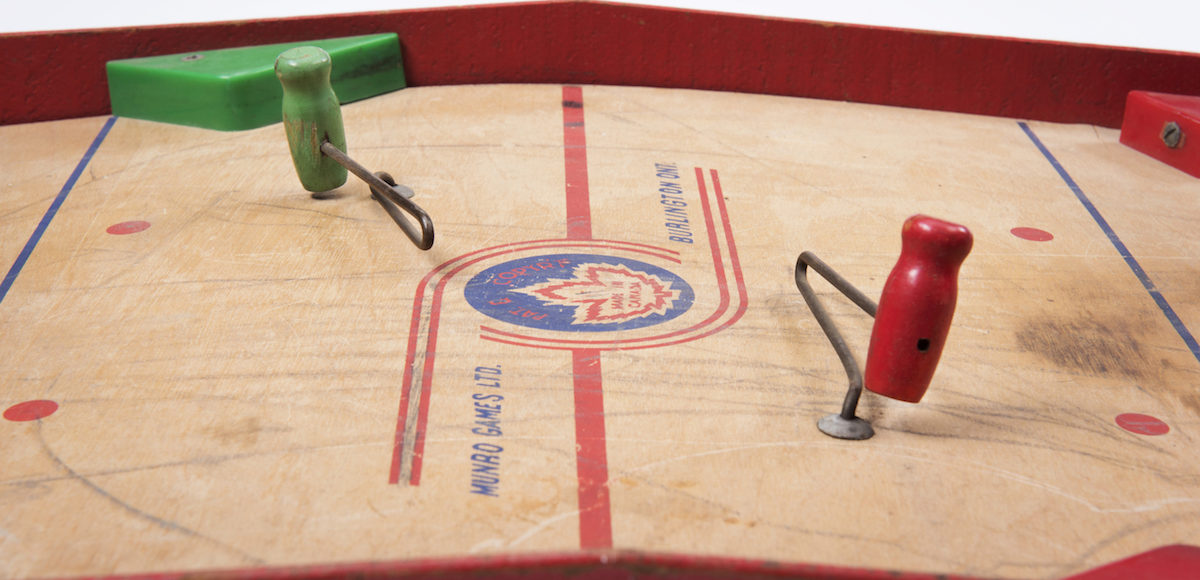Many years ago, shortly after they invented ice, I played in a minor hockey league that welcomed any limp-ankled kid who had stick and skates. I was put on a team, the name of which I can’t quite remember, and in our first few games the other teams so decisively wiped the ice with us that I’m surprised they didn’t call us the Zamboni boys. We were firmly in last place.
Meanwhile, the Holman’s Rockets — I remember that name — had handily won all their games and were in first place. The league was so unbalanced that a trade was ordered between the top and bottom teams. Being the worst on the worst team, I was traded and became the worst on the best team, and that team enjoyed an undefeated, championship season.
As far as I know it was the only trade in league history. I still feel sorry for the guy from the No. 1 team who was sent down to the basement team, the poor bastard.
Such personal memories are not found in the exhibition Hockey, now at the Canadian Museum of History, but many collective memories rise from the 280 artifacts on display, including jerseys worn at key moments. Many Canadians remember where they were when Paul Henderson scored to beat the Russians in 1972 (I was in my Grade 6 classroom), or when Sydney Crosby scored to win Olympic gold for Canada in 2010 (I was in a friend’s living room), or when Shania Twain hosted the Juno Awards in 2003 while wearing a spangly, revealing Montreal Canadians outfit (I was lost in an unprintable fantasy).
Canada’s year-long 150th birthday party is a fitting time to consider such memories, and the “national and personal obsession” that is perhaps as old as the nation itself.
The exhibition begins with primitive sticks and pucks, and explains how early players sometimes used “frozen clumps of dung” as pucks, which must have been unpleasant for spectators on warmer days. One idly wonders if that’s where “when the sh-t hits the fan” began.
There are the first hockey trading cards, from 1910, and a Toronto Maple Leafs sweater worn by “Fearless” Frank Finnigan, who in 1927 had won the Stanley Cup with the Ottawa Senators. There’s a jersey from the awesomely named Trail Smoke Eaters that was worn by Larry Kwong before he “broke the colour barrier in elite professional hockey” with the New York Rangers in 1948.
A space designed to look like a dressing room, with pads and helmets in pockets along the walls, showcases sticks used by some of the greatest names in the game, including Wayne Gretzky, Ken Dryden and Stan Mikita — with a photograph of Mikita “smoking a cigarette in the dressing room.” Ah, the good old days.
There’s Jacques Plante’s “pretzel” goalie mask, and the mask onto which Gerry Cheevers drew stitches every time he took a puck to the face, a project that “inspired other goalies to personalize their masks.”
There are also iconic souvenirs of women in the game, including the skates that Hayley Wickenheiser wore when Canadian women won Olympic gold in 2010, and the Team Canada stick of goalie Manon Rheaume, who in 1992 became the first woman to play in the NHL.
Some artifacts miss the net. A display on NHL commentators includes a camo jacket Don Cherry wore when he honoured Canadian soldiers in Afghanistan, but the jacket, while made of good intentions, is not typical of Cherry’s famously awful fashion sense, though it should be. Nearby is a 35-mm camera used by photographer Frank Lennon during that Canada-Russia series in 1972, though it’s a mystery what such a generic item could say about our relationship with the game.
Not everything offered glorifies the game. Artworks include National Pastimes, by the Cree Sioux Métis artist Jim Logan, which considers how the game diverts attention from “the painful social and economic realities affecting indigenous communities.” A nearby cabinet contains the in-line skates and helmet worn by Sheldon Kennedy on his cross-country trek to support survivors of sexual abuse.
Lighter moments prevail, for the most part. One space is shaped like a mini rink, with four TV screens arranged like a Jumbotron and looping video of great moments — Maurice Richard’s 500th goal, those goals by Henderson and Crosby and Lemieux, and oddities, like goalie Ron Hextall’s goal.
Elsewhere are endearing pieces, such as the championship wallet earned by midget AA coach Pat Burns, the now late Gatineau cop who rose to NHL history, and there’s a sign made by an Ottawa family to motivate the Senators’ Bobby Ryan during a 2016 game — “Dad said if you score we get a puppy!” Ryan scored, and the puppy is named Bobby.
No mention of the sign I saw an amorous young woman holding up at a Senators’ game about 15 years ago: “Chara, my boyfriend is still out of town!”
Let’s hope he wasn’t watching the game on a distant TV. Ahem.
Hockey continues to Oct. 9.







